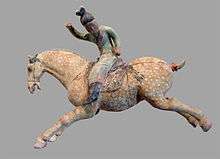Four Garrisons of Anxi
| Four Garrisons of Anxi | |||||||||
| Traditional Chinese | 安西四鎮 | ||||||||
|---|---|---|---|---|---|---|---|---|---|
| Simplified Chinese | 安西四镇 | ||||||||
| |||||||||
The Four Garrisons of Anxi were Chinese military garrisons installed by the Tang Dynasty between 648 and 658. They were stationed at the Indo-European city-states of Kucha, Khotan, Kashgar and Karashahr. Kucha was also the seat of the Protectorate General to Pacify the West. The troops were sent and stationed here from within Tang China proper.[1]
Based upon the Chinese texts, the Tang campaign against Kucha in 648 established Tang rule over the entire Tarim Basin. According to Zhang Guangda's theory, this is in part due to a number of inaccurate Chinese sources linking the expedition to the establishment of the Four Garrisons of Anxi. However, Zhang Guangda has used hints from excavated texts from Gaochang (Karakhoja or Turfan) dated to 654 to show that the Tang abandoned the attempt to move the headquarters of the Protectorate of the Pacified West to Kucha after the Protector-general Guo Xiaoke's assassination by Kuchean resistance forces. Instead the headquarters returned to Gaochang until 658, when it was moved back to Kucha following a Tang army's suppression of a local pro-Turk revolt.[2] The Tang only gained a loose suzerainty over the Tarim Basin states in 649, and did not establish military garrisons in the Tarim Basin. Most of the Tarim Basin states transferred their vassalage to the new Western Turk qaghan, Ashina Helu, in 651, reflecting the fact that they regarded the Western Turks as their traditional overlords. The establishment of the Four Garrisons, and with them a formal Tang military protectorate over the Tarim Basin, should be dated to 658 (after Ashina Helu's defeat) or even to 660, since Kashgar remained allied with the Western Turk leader Duman until Duman's defeat in later 659.
The main challengers to the Chinese for hegemony over the region were the Tibetans, who had been invading the region since 662 and seized it in 670, interrupting Chinese sovereignty in the area. According to Chinese texts, during this period the Chinese re-captured some or all of the garrisons in 675, 679, 682 and again in 686.[3] However this is disputed by Christopher Beckwith.[4]Nevertheless, Kashgar surrendered to China in 673 and Khotan in 674. Meanwhile, in 679, another fortress was built in Suyab, situated near the Chui River, this would later replace Karashahr as one of the Four Garrisons until 719, when the Turgesh took over it.[1]
With the defeat of the Tibetans in 692, and after a brief seizure of Kucha by the Turgesh for 8 months in 709, the Four Garrisons were continuously controlled by the Chinese. Even though most of the regular prefectures at Hexi Corridor, such as Liangzhou (764), Ganzhou, Suzhou (766), Guazhou (776), Yizhou (781) and Shazhou (787) were occupied between the 760s and 780s by the Tibetans, and contact between the Tarim Basin and the capital were limited, the isolated Chinese troops left in the Tarim Basin continued to hold these garrisons until 790 as attested by the pilgrim monk Wukong. In the year 790 the garrisons along with the seat of the Protectorate to Pacify the West fell one by one into Tibetan hands.[5]
See also
Notes
References
- Beckwith, Christopher. (1987). The Tibetan Empire in Central Asia. Princeton, NJ: Princeton University Press. ISBN 0-691-05494-0.
- Chen, Guocan. "Anxi Sizhen" ("Four Garrisons of Anxi"). Encyclopedia of China (Chinese History Edition), 1st ed.
- Wang, Xiaofu (王小甫). (1992). History of the Political Relationship Between the Tang, Tibetans, and Arabs (唐、吐蕃、大食政治關係史). Beijing: Beijing daxue chubanshe. ISBN 7-301-01962-9.
- Xue, Zongzheng (薛宗正). (1992). History of the Turks (突厥史). Beijing: Zhongguo shehui kexue chubanshe. ISBN 978-7-5004-0432-3; OCLC 28622013
- Zhang, Guangda (張廣達). (1995). Xiyu shidi conggao chubian (Collected Drafts on the Historical Geography of the Western Regions, Vol. 1) (西域史地叢稿初編). Shanghai: Shanghai guji chubanshe. ISBN 7-5325-1877-9
